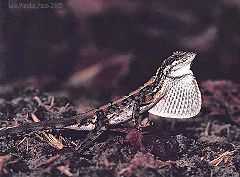Sitana ponticeriana
| Fan-throated lizard | |
|---|---|
 | |
| Conservation status | |
| Scientific classification | |
| Kingdom: | Animalia |
| Phylum: | Chordata |
| Class: | Reptilia |
| Order: | Squamata |
| Suborder: | Lacertilia |
| Infraorder: | Iguania |
| Family: | Agamidae |
| Subfamily: | Agaminae |
| Genus: | Sitana |
| Species: | S. ponticeriana |
| Binomial name | |
| Sitana ponticeriana Cuvier, 1829 | |
 | |
_W_IMG_7530.jpg)
The fan-throated lizard (Sitana ponticeriana) is a species of agamid lizard found in India, Sri Lanka, and parts of Pakistan.[1]
The species is found mostly on the ground in open ground patches in thin forests. When disturbed this lizard sometimes runs with a bipedal gait.
Descriptions
_W2_IMG_7581.jpg)
Upper head-scales small, sharply keeled; canthus rostralis and supraciliary edge sharp, with much enlarged scales. Dorsal scales larger than ventrals, with sharp keels forming straight longitudinal lines; lateral scales smallest, uniform or intermixed with scattered enlarged ones. The fore limb does not extend on to the vent, if laid backwards; the hind limb reaches to the orbit, if laid forwards; the lower thigh is rather shorter than the foot (measured from the heel to the tip of the longest toe), the length of which is only three-fourths of the distance between the shoulder and hip joints. Limbs above with uniform strongly keeled scales. The length of the limbs varies very much : in some specimens the hind limb stretched forwards does not extend beyond the orbit, in others it reaches the end of the snout or even considerably beyond. Brown, with a series of dark spots along the middle of the back, the spot on the neck being the darkest; a whitish band along each side of the back. Gular appendage tricoloured—blue, black, and red.[2]
Tail round, slender, once and a half to twice as long as the head and body, covered with equal keeled scales. Olive-brown above, with a series of rhomboidal spots along the middle of the back; a more or less distinct light band along each side of the back. Gular appendage tricoloured—blue, black, and red; this appendage is more developed in the breeding-season, and in the majority of individuals, at all events, is not coloured at other times.[3]
This species attains a maximum length of 8 inches, of which the tail takes 5 inches. From snout to vent 3-5 inches. Ebanasar (1989) reported the histomorphology of thyroid gland and thyroid activity in Sitana ponticeriana in juveniles, males and females with different ovary maturation stages. He has also reported ovoviviparity in females from Madurai and Virudhunagar areas of Tamil Nadu.[4]
M. A. Smith notes that there are two size variants with intermediates :
- A larger form. From snout to vent 70–80 mm. ; tail once and a half to twice the length of the head and body ; hind-limb not reaching to beyond the snout;, lateral scales not intermixed with larger ones ; no enlarged scales on the occiput. This form appears to be confined to the district around Bombay. This may possibly represent Jerdon's deccanensis.
- A smaller form. From snout to vent 40–50 mm. ; tail two to three times the length of the head and body ; hind-limb reaching to beyond the tip of the snout ; lateral and occipital scales intermixed with larger ones. This form ranges over the rest of India and Ceylon. The typical form is from Pondicherry, and Gunther's minor, from Madras, is, therefore, a synonym of it.[5]
Distribution
India from the base of the Himalayas to Cape Comorin, and from the Punjab and Kachchh (not Sind) to Western Bengal; Sri Lanka.
Different views
-
_W_IMG_7586.jpg)
in Hyderabad, India
-
_W_IMG_7581.jpg)
in Hyderabad, India
-
_I_IMG_0528.jpg)
at Pocharam lake, Andhra Pradesh, India
-
_W_IMG_7579.jpg)
in Hyderabad, India
-
_W2_IMG_7579.jpg)
in Hyderabad, India
Cited references
| Wikimedia Commons has media related to Sitana ponticeriana. |
- ↑ 1.0 1.1 Vyas, R.V. (2010). "Sitana ponticeriana". IUCN Red List of Threatened Species. Version 2013.1. International Union for Conservation of Nature. Retrieved 27 July 2013.
- ↑ C. A. L. Gunther's (1864) The Reptiles of British India.
- ↑ G. A. Boulenger (1890) Fauna of British India. Reptilia and Batrachia.
- ↑ Ebanasar J. (1989), Histomorphology of thyroid gland in a ground lizard Sitana ponticeriana, M.Sc Dissertation submitted to Madurai Kamaraj University
- ↑ Smith, M. A. 1941. Fauna of British India. Reptilia and Amphibia
Other references
- Cuvier, G. J. L. N. F. D. 1829 Le Règne Animal Distribué d'après son Organisation, pour servir de base à l'Histoire naturelle des Animaux et d'introduction à l'Anatomie Comparée. Nouvelle Edition. Vol. 2. Les Reptiles. Déterville, Paris, i-xvi, 1-406
- Jerdon,T.C. 1870 Notes on Indian Herpetology. P. Asiatic Soc. Bengal March 1870: 66-85
- Kelaart, Edward Fred 1854 Catalogue of reptiles collected in Ceylon. Ann. Mag. Nat. Hist. (2) 13: 137-140
- Ebanasar J. 1989. Histomorphology of thyroid gland in a ground lizard Sitana ponticeriana. M.Sc Dissertation submitted to Madurai Kamaraj University.
- Ebanasar J. and N.Inbamani 1989. Histomorphology of thyroid gland in a ground lizard Sitana ponticeriana (Cuvier). ANJAC Journal. 9:85-95.
External links
- Sitana ponticeriana at the Reptarium.cz Reptile Database
- http://itgmv1.fzk.de/www/itg/uetz/herp/photos/Sitana_ponticeriana.jpg
